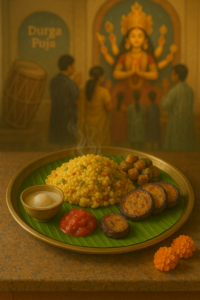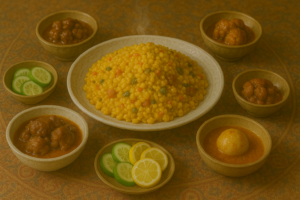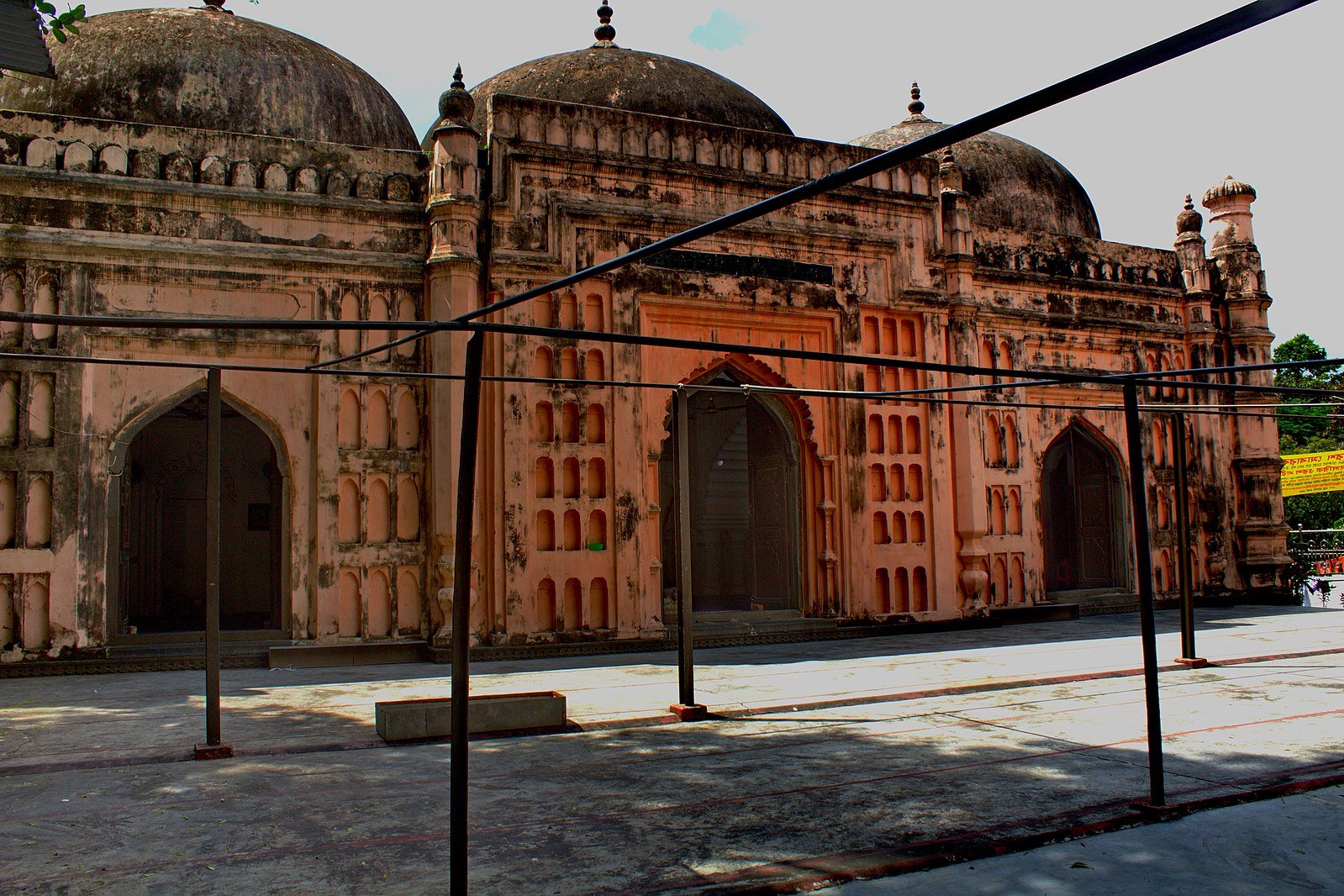Khichuri in Bangali Festivals: A Bowl Full of Warmth, Worship & Togetherness
When the clouds gather and the smell of ghee fills the house, you just know—khichuri is on the stove.
Khichuri is a cherished dish in Bengali cuisine which is very healthy and light on palette. Particularly during festivals, it’s a one-pot dish of rice and lentils, often cooked with various spices and vegetables. From rainy-day comfort food to sacred offerings during the grandest celebrations, khichuri is woven into the very fabric of Bengali culture. It’s not just a dish—it’s a memory, a ritual, and a symbol of unity.
Comfort Food
Khichuri is widely regarded as a comforting and nourishing dish, especially during rainy days. Even outside the grand festivals, khichuri is the star of many smaller, everyday celebrations—especially during the monsoon. On a rainy afternoon, when the skies are grey and the air smells of petrichor, Bengalis turn to their ultimate comfort food: patla khichuri.
Served hot with fried hilsa, omelets, or even just a dollop of ghee and pickles, this version of khichuri is cozy, nostalgic, and made to soothe the soul.
The history of Khichuri
The origin of Khichuri dates back to ancient Indian cuisine, where it began as a basic dish of rice and lentils. Over time, it made its way into Mughal cuisine, becoming more elaborate with the addition of spices and meats. During colonial Bengal, Khichuri a staple in both rural and households. The Bengali word ‘Khichuri’ has been derived from the term ‘khichdi’ which comes from the Sanskrit word ‘khiccha; meaning a dish of rice and legumes. It is also believed that khichdi is the inspiration behind Anglo Indian ‘Kedgeree,’ a dish consisting of cooked flaked fish (traditionally smoked handdock), boiled rice, parsley, hard-boiled eggs, curry powder, butter or cream.
Interestingly, khichdi also went to England and onto the royal dinner plate of Queen Victoria through her Urdu tutor Munshi Abdul Karim. He made her sample some, but she, however,preferred rice mixed with masoor daal.
Basically, khichuri is rice and lentils cooked together with lots of seasonal veggies and assortment of spices, both whole and powdered. The speciality of this khichuri is the hint of ‘sugar’ and the quality of rice being used. Usually, it is made with rice called ‘Govindubhog’ which is packed with fragrance and that gives a special festive flavor to this khichuri.
Durga Puja & Bhoger Khichuri
Durga Puja, the grandest festival for Bengali Hindus, is incomplete without bhoger khichuri. This special version is prepared as an offering (bhog) to Goddess Durga. Cooked without onion and garlic, it’s a simple yet divine combination of gobindobhog rice, moong dal, vegetables like cauliflower and green peas, and a touch of ghee.
The real beauty lies in its sacred simplicity. Served with fried eggplants (begun bhaja), tomato chutney, and sweets like payesh, bhoger khichuri brings back childhood memories of standing in line at the pandal, plate in hand, heart full of joy. Why Is It Special?
In the heart of every puja mandap, after the Pushpanjali (flower offering), comes the most awaited part—the bhog. Devotees gather in long lines with plates, their hearts filled with devotion and stomachs waiting for that warm, sacred meal.

What makes Bhoger Khichuri so special?
It is offered first to the goddess as Prasad. It’s usually cooked in large, communal pots by volunteers. The atmosphere is filled with chanting, the beat of dhaak, and the smell of ghee. It’s not just about taste—it’s about emotion and collective memory.
The Traditional Bhog Thali
A typical bhog plate during Durga Puja includes:
- Bhoger khichuri
- Labra – a medley of vegetables cooked with panch foron
- Begun bhaja – crispy fried eggplants
- Tomato chutney – sweet and tangy
- Payesh or rosogolla – a sweet ending
Together, it’s a meal that feels festive, nostalgic, and holy all at once. Unlike everyday khichuri, bhoger khichuri is cooked with strict rituals:
Only pure ingredients are used. Cooked in a clean, sacred space. Stirred with care, sometimes even while chanting mantras. Served to everyone with humility and love. Even if it’s simple, this khichuri is filled with spiritual richness.
Eid & Bhuna Khichuri: A Feast of Flavor
Eid morning means perfume in the air, laughter in the house, and the smell of bhuna khichuri rising from the kitchen.
For Bengali Muslims, Eid is not just a religious celebration—it’s a festival of togetherness, hospitality, and indulgence. And at the heart of the Eid dining table lies one beloved, golden dish ‘Bhuna Khichuri.’ It’s not just food. It’s tradition, comfort, and celebration—all on one plate. Unlike the soft, runny khichuri of rainy days or the no-onion bhog version of Durga Puja, Eid’s bhuna khichuri is a rich, dry, spiced variation of rice and lentils. It is made with fragrant basmati rice or kalijeera rice, fried and simmered with aromatic spices like cardamom, cinnamon, and bay leaves, cooked with roasted moong dal or chholar dal for depth,enriched with ghee and sometimes saffron. Often garnished with fried onions or raisins.This khichuri isn’t shy—it’s bold, festive, and deeply flavorful.
The Eid Pairing: Bhuna Khichuri & Meat Delights
On Eid day, bhuna khichuri shines best when served with lavish side dishes such as:
- Beef Rezala – slow-cooked, milky-spiced beef curry
- Chicken Roast – Mughlai-style chicken in a sweet, aromatic gravy
- Dim er Korma – eggs simmered in a rich onion-yogurt sauce
- Shutki Bhuna or Begun Bharta – depending on family tradition
- A wedge of lemon and a slice of fresh cucumber on the side
It’s a feast that satisfies not just the stomach, but the spirit.

Other Festive Faces of Khichuri
While Bhoger Khichuri and Bhuna Khichuri steal the spotlight during Durga Puja and Eid, respectively, khichuri also plays a quiet yet delightful role in many other Bengali festivals and life events.
Poush Parbon & Winter Khichuri:
During Poush Parbon—the winter harvest festival—families in rural Bengal often prepare khichuri using newly harvested rice, called notun chaal. This version is paired with seasonal vegetables like peas, carrots, and cauliflower, cooked in mustard oil for an earthy flavor. A side of fried fish or thick egg curry adds the perfect winter warmth.
Shraddha Ceremony:
Khichuri also holds significance during shraddha, a Hindu ritual performed in honor of ancestors. Here, it is prepared with simplicity, usually devoid of onion and garlic, and served with labra, payesh, and fruits. It’s a meal of remembrance—quiet, humble, and deeply spiritual.
Janmashtami or Saraswati Puja:
On these auspicious occasions, khichuri is often part of the offering, especially in homes and schools. A lighter, sattvik (pure vegetarian) version is cooked and served with joy among children and devotees, evoking a sense of purity and togetherness.
Wedding Preparations & Gaye Holud:
Even in Bengali weddings, especially during the gaye holud or turmeric ceremony, a large pot of khichuri often finds its way into the menu—usually paired with beguni, fried fish, and salad. It’s affordable, filling, and loved by all generations.
Khichuri is not just something we eat—it’s something we feel. It reminds us of childhood afternoons, festival mornings, family lunches, and moments of quiet comfort. In every Bengali home, khichuri is more than a recipe—it’s a memory passed from one generation to another. No matter where life takes us, one plate of khichuri can always bring us back home.








